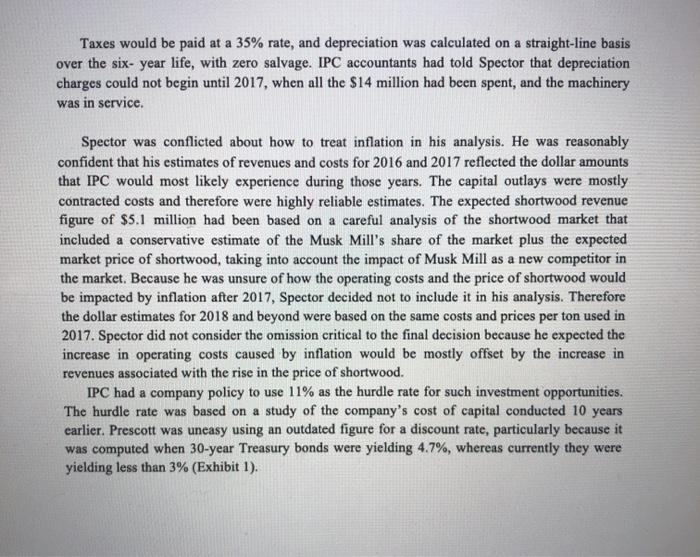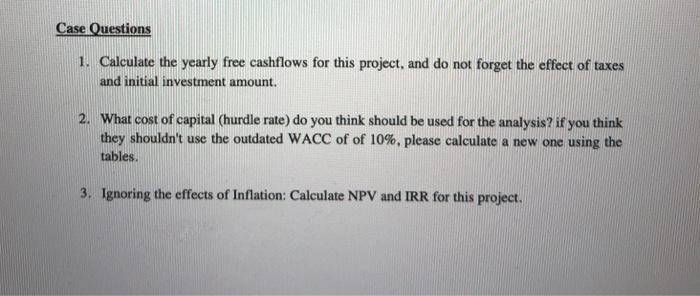International Paper Company In January 2016, Michael Spector, the manager for the Musk Mill, was considering the addition of a new on-site longwood woodyard. The addition would have two primary benefits: it would eliminate the need to purchase shortwood from an outside supplier, and it would create the opportunity to sell shortwood on the open market as a new market for International Paper Company (IPC). Now the new woodyard would allow the Musk Mill not only to reduce its operating costs but also to increase its revenues. The proposed woodyard utilized new technology that allowed tree- length logs, called longwood, to be processed directly, whereas the current process required shortwood, which had to be purchased from the White Mill. This nearby mill, owned by a competitor, had excess capacity that allowed it to produce more shortwood than it needed for its own pulp production. The excess was sold to several different mills, including the Musk Mill. Thus adding the new longwood equipment would mean that Spector would no longer need to use the White Mill as a shortwood supplier and that the Musk Mill would instead compete with the White Mill by selling on the shortwood market. The question for Spector was whether these expected benefits were enough to justify the $14 million capital outlay plus the incremental investment in working capital over the six-year life of the investment. Construction would start within a few months, and the investment outlay would be spent over two calendar years: $13 million in 2016 and the remaining S1 million in 2017. When the new woodyard began operating in 2017, it would significantly reduce the operating costs of the mill. These operating savings would come mostly from the difference in the cost of producing shortwood on-site versus buying it on the open market and were estimated to be $1.5 million for 2017 and $2.5 million per year thereafter. Spector also planned on taking advantage of the excess production capacity afforded by the new facility by selling shortwood on the open market as soon as possible. For 2017, he expected to show revenues of approximately $5.1 million, as the facility came on-line and began to break into the new market. He expected shortwood sales to reach $9.5 million in 2018 and continue at the $9.5 million level through 2022. Spector estimated that the cost of goods sold (before including depreciation expenses) would be 50% of revenues, and SG&A would be 10% of revenues. In addition to the capital outlay of $14 million, the increased revenues would necessitate higher levels of inventories and accounts receivable. The total working capital would average 15% of annual revenues. Therefore the amount of working capital investment each year would equal 15% of incremental sales for the year. At the end of the life of the equipment, in 2022, all the net working capital on the books would be recoverable at cost, whereas only 20% or $2.8 million (before taxes) of the capital investment would be recoverable. Taxes would be paid at a 35% rate, and depreciation was calculated on a straight-line basis over the six-year life, with zero salvage. IPC accountants had told Spector that depreciation charges could not begin until 2017, when all the $14 million had been spent, and the machinery was in service. Spector was conflicted about how to treat inflation in his analysis. He was reasonably confident that his estimates of revenues and costs for 2016 and 2017 reflected the dollar amounts that IPC would most likely experience during those years. The capital outlays were mostly contracted costs and therefore were highly reliable estimates. The expected shortwood revenue figure of $5.1 million had been based on a careful analysis of the shortwood market that included a conservative estimate of the Musk Mill's share of the market plus the expected market price of shortwood, taking into account the impact of Musk Mill as a new competitor in the market. Because he was unsure of how the operating costs and the price of shortwood would be impacted by inflation after 2017, Spector decided not to include it in his analysis. Therefore the dollar estimates for 2018 and beyond were based on the same costs and prices per ton used in 2017. Spector did not consider the omission critical to the final decision because he expected the increase in operating costs caused by inflation would be mostly offset by the increase in revenues associated with the rise in the price of shortwood. IPC had a company policy to use 11% as the hurdle rate for such investment opportunities. The hurdle rate was based on a study of the company's cost of capital conducted 10 years earlier. Prescott was uneasy using an outdated figure for a discount rate, particularly because it was computed when 30-year Treasury bonds were yielding 4.7%, whereas currently they were yielding less than 3% (Exhibit 1). Exhibit 1 International Paper Company Cost-of-Capital Information Bank loan rates (LIBOR) 1-year 1.67% Interest Rates: January 16, 2016 Market risk premium Historical average 7.0% Government bonds 1-year 0.49% 5-year 1.46% 10-year 2.08% 30-year 2.82% Corporate bonds (10-year maturities) 2.45% 3.38% 3.90% Baa 5.05% International Paper Financial Data Balance sheet accounts (in millions of dollars) Bank loan payable (LIBOR + 1%) Long-term debt Common equity Retained earnings 750 2,500 750 3,000 500 Per-share data Shares outstanding (millions) Book value per share Recent market value per share $ 7.00 $34.00 A Other Bond rating Beta 1.60 Case Questions 1. Calculate the yearly free cashflows for this project, and do not forget the effect of taxes and initial investment amount. 2. What cost of capital hurdle rate) do you think should be used for the analysis? if you think they shouldn't use the outdated WACC of of 10%, please calculate a new one using the tables. 3. Ignoring the effects of Inflation: Calculate NPV and IRR for this project. A B D E F G H 2016 2017 2018 2019 2020 2021 2022 22 Investment 3 Capital Outlay Net Working Capital (15% Sales) 5 Total Investment Investment Recovery: Equipment Salvage 3 Net Working Capital (full recovery) Earnings before Interest and Taxes (EBIT): 1 Sales Revenue 2 3 Cost of Goods Sold (50% Sales) 4 SG&A (10% Sales) 5 Operating Savings 6 Depreciation ($14,000/6) 7 Total Costs & Expenses 9 EBIT Taxes (35%) 2 Depreciation 3 - Investment 4 = Free Cash Flow 5 6 NPV A WACC = TRR E Sheet1











